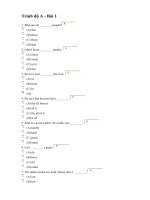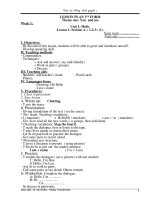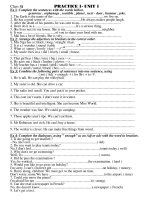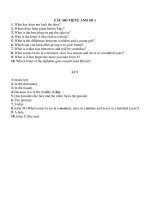- Trang chủ >>
- Đề thi >>
- THPT Quốc Gia
Tiếng anh MH2 1
Bạn đang xem bản rút gọn của tài liệu. Xem và tải ngay bản đầy đủ của tài liệu tại đây (164.22 KB, 8 trang )
ĐỀ MINH HỌA SỐ 40
THEO HƯỚNG TINH GIẢN BÁM
SÁT ĐỀ MINH HỌA BGD LẦN 2
ĐỀ THI THỬ THPTQG NĂM 2020
CHUẨN CẤU TRÚC CỦA BỘ GIÁO DỤC
Môn thi: TIẾNG ANH
Thời gian làm bài: 60 phút, không kể thời gian phát đề
Họ, tên thí sinh:.......................................................................
Số báo danh:............................................................................
Mark the letter A, B, C, or D to indicate the word whose underlined part differs from the other three in
pronunciation in each of the following questions.
Question 1. A. pencils
B. installs
C. commits
D. motors
Question 2. A. species
B. nest
C. special
D. helpful
Mark the letter A, B, C, or D to indicate the word that differs from the other three in the position of the
primary stress in each of the following questions.
Question 3. A. lawyer
B. sugar
C. fitness
D. prevent
Question 4. A. society
B. epidemic
C. initiate
D. catastrophe
Mark the letter A, B, C or D to indicate the correct answer to each of the following questions.
Question 5. Your mother sometimes buys you a big present, ________?
A. does she
B. doesn’t she
C. isn’t she
D. didn’t she
Question 6. Last night, there was _________ bird singing outside my house.
A. a
B. an
C. the
D. Ǿ
Question 7. Hoa hoped ________ to join the club. She could make friends with many people here.
A. being invited
B. to invite
C. to be invited
D. inviting
Question 8. If he had known her address, he ________ her to his birthday party last week.
A. would have invited
B. would have invite
C. will invite
D. would invite
Question 9. After he ________ the house, he wrote a letter.
A. cleans
B. had cleaned
C. has cleaned
D. was cleaning
Question 10. ________ his good work and manners, he didn’t get a promotion.
A. Because of
B. In spite of
C. Even though
D. As a result of
Question 11. ________ Paul realize that he was on the wrong flight.
A. No sooner had the plane taken off than
B. It was not until the plane had taken off that
C. Only after the plane had taken off
D. Not until the plane had taken off did
Question 12. Students are ________ less pressure as a result of changes in testing procedures.
A. under
B. above
C. upon
D. out of
Question 13. Many of the pictures ________ from outer space are presently on display in the public
library
A. sending
B. sent
C. which sent
D. which is sending
Question 14. Some men are concerned with physical ________ when they choose a wife.
A. attract
B. attractive
C. attractiveness
D. attractively
Question 15. Governments should ________ some international laws against terrorism.
A. bring up
B. bring about
C. bring in
D. bring back
Question 16. We are all very sorry that we have to wait for this agreement to come into ________.
A. truth
B. action
C. force
D. reality
Question 17. Making mistakes is all ________ of growing up.
A. bits and bobs
B. chalk and cheese
C. part and parcel
D. from top to bottom
Question 18. My grandmother ________ her whole life to looking after her children.
A. paying
B. using
C. spending
D. devoting
Question 19. In Africa, people's interference in the rhino's ________ leads to habitat loss.
A. sector
B. territory
C. domain
D. country
Mark the letter A, B, C or D to indicate the word(s) CLOSEST in meaning to the underlined word(s) in
each of the following questions.
Question 20. When our rent increased from $100 to $200 a month, we protested against such a
tremendous increase.
A. light
B. huge
C. tiring
D. difficult
Question 21. The new cartoon film catches the fancy of the children.
A. satisfies
B. amuses
C. attracts
D. surprises
Mark the letter A, B, C or D to indicate the word(s) OPPOSITE in meaning to the underlined word(s)
in each of the following questions.
Question 22. Lisa rarely smiles because she’s shy about exposing her crooked teeth.
A. pulling
B. hiding
C. showing
D. brushing
Question 23. Tom may get into hot water when driving at full speed after drinking wine.
A. get into trouble
B. stay safe
C. fall into disuse
D. keep calm
Mark the letter A, B, C, or D to indicate the sentence that best completes each of the following
exchanges.
Question 24. Huy was asking Mai, his classmate, for her opinion about the book he had lent her.
- Huy: “What do you think about the book?”
- Mai: “________”
A. Yes, let’s read it together.
B. The best I’ve ever read!
C. I can’t agree with you more.
D. I wish I could buy one.
Question 25. Two friends Diana and Anne are talking about their upcoming exams.
- Diana: “Our midterm exams will start next Tuesday, are you ready?”
- Anne: “________”
A. I’m half ready.
B. God save you.
C. Thank you so much
D. Don’t mention it!
Read the following passage and mark the letter A, B, C, or D to indicate the correct word or phrase
that best fits each the numbered blanks.
Welcome to the Netherlands, a tiny country that only extends, at its broadest, 312 km north to south,
and 264 km east to west - (25) ________ the land area increases slightly each year as a result of
continuous land reclamation and drainage. With a lot of heart and much to offer, ‘Holland,’ as it is (26)
________known to most of us abroad - a name stemming from its once most prominent provinces - has
more going on per kilometer than most countries, and more English-speaking natives. You’ll be impressed
by its (27) ________ cities and charmed by its countryside and villages, full of contrasts. From the
exciting variety on offer, you could choose a romantic canal boat tour in Amsterdam, a Royal Tour by
coach in The Hague, or a hydrofoil tour around the biggest harbour in the world - Rotterdam. In season
you could visit the dazzling bulb fields, enjoy a full day on a boat, or take a bike tour through the
pancake-flat countryside spiced with windmills. The possibilities are countless and the nationwide tourist
office is on hand to give you information and help you (28) ________reservations. You’ll have (29)
________ language problems here, as the Dutch are true linguists and English is spoken here almost
universally.
Question 26. A. so
B. despite
C. in spite of
D. although
Question 27. A. regularly
B. occasionally
C. commonly
D. unusually
Question 28. A. historic
B. historical
C. historically
D. historian
Question 29. A. sit
B. catch
C. do
D. make
Question 30. A. few
B. a few
C. little
D. a little
Read the following passage and mark the letter A, B, C, or D to indicate the answer to each of the
question.
Dinosaurs were reptiles that lived during a period of earth’s history called the Mesozoic Era, which is
known as the Age of Reptiles. The first dinosaurs appeared more than 200 million years ago. For many
millions of years, they dominated the land with their huge size and strength. Then about 65 million years
ago, they died out rather suddenly, never to reemerge.
The word dinosaur comes from two Greek words meaning “terrible lizard”. Dinosaurs were not
lizards, but their appearance could be truly terrifying. The biggest ones weighed more than ten times as
much as a mature elephant and nearly equaled the size of most modern-day whales. The famous kinds of
dinosaurs, including the brontosaurus and tyrannosaurus, reached 80 to 90 feet in length. Not all
dinosaurs were giants, however, some were actually no larger than a chicken.
Scientists still do not know what caused dinosaur to disappear. One theory involves a change in the
earth’s climate. It is believed that temperature dropped significantly towards the end of the Cretaceous
Period. Too large to hibernate and not having fur or feathers for protection, it is possible that the climate
became too chilly for dinosaurs. In contrast, other species having protection, such as the mammals and
birds, were able to survive.
Question 31. What is the best title for this passage?
A. The Domination of the Land
B. Dinosaurs and their extinction
C. Earth’s Largest Reptiles
D. The History of Earth
Question 32. The word “ones” in the passage refers to __________
A. dinosaurs
B. millions
C. lizards
D. whales
Question 33. It can be inferred from the passage that the Age of Reptiles lasted about _______
A. 200 million years
B. 135 million years
C. 80 million years
D. 65 million years
Question 34. The word “chilly” in the passage refers to _________
A. very hot
B. extremely cold
C. very cold
D. humid
Question 35. According to the passage, what is TRUE about the size of dinosaurs?
A. It made them the largest creatures ever on earth.
B. It varied quite greatly.
C. It guaranteed their survival.
D. It was rather uniform.
Read the following passage and mark the letter A, B, C, or D to indicate the answer to each of the
question.
In the North American colonies, red ware, a simple pottery fired at low temperatures, and stone ware,
a strong, impervious grey pottery fired at high temperatures, were produced from two different native
clays. These kinds of pottery were produced to supplement imported European pottery. When the
American Revolution (1775-1783) interrupted the flow of the superior European ware, there was
incentive for American potters to replace the imports with comparable domestic goods. Stoneware, which
had been simple utilitarian kitchenware, grew increasingly ornate throughout the nineteenth century, and
in addition to the earlier scratched and drawn designs, three-dimensional molded relief decoration became
popular. Representational motifs largely replaced the earlier abstract decorations. Birds and flowers were
particularly evident, but other subjects - lions, flags, and clipper ships - are found. Some figurines, mainly
of dogs and lions, were made in this medium. Sometimes a name, usually that of the potter, was diestamped onto a piece.
As more and more large kilns were built to create the high-fired stoneware, experiments revealed that
the same clay used to produce low-fired red ware could produce a stronger, paler pottery if fired at a
hotter temperature. The result was yellow ware, used largely for serviceable items; but a further
development was Rockingham ware - one of the most important American ceramics of the nineteenth
century. (The name of the ware was probably derived from its resemblance to English brown-glazed
earthenware made in South Yorkshire.) It was created by adding a brown glaze to the fired clay, usually
giving the finished product a mottled appearance. Various methods of spattering or sponging the glaze
onto the ware account for the extremely wide variations in color and add to the interest of collecting
Rockingham. An advanced form of Rockingham was flint enamel, created by dusting metallic powders
onto the Rockingham glaze to produce brilliant varicolored streaks.
Articles for nearly every household activity and ornament could be bought in Rockingham ware:
dishes and bowls, of course; also bedpans, foot warmers, cuspidors, lamp bases, doorknobs, molds,
picture frames, even curtain tiebacks. All these items are highly collectible today and are eagerly sought.
A few Rockingham specialties command particular affection among collectors and correspondingly high
prices.
Question 36. The word “ornate” in paragraph 1 is closest in meaning to ____________.
A. elaborate
B. puzzling
C. durable
D. common
Question 37. The passage suggests that the earliest stoneware ____________.
A. was decorated with simple, abstract designs
B. used three-dimensional decorations
C. was valued for its fancy decorations
D. had no decoration
Question 38. How did yellow ware achieve its distinctive color?
A. By sponging on a glaze
B. By dusting on metallic powders
C. By brown-glazing
D. By firing at a high temperature
Question 39. The phrase “derived from” in paragraph 2 is closest in meaning to ____________.
A. ruined by
B. warned against
C. based on
D. sold by
Question 40. The word “It” in paragraph 2 refers to __________.
A. red ware
B. yellow ware
C. Rockingham ware
D. English brown-glazed earthenware
Question 41. The phrase “account for” in paragraph 2 is closest in meaning to __________.
A. explain
B. restrict
C. finance
D. supplement
Question 42. What was special about flint enamel?
A. Its even metallic shine
B. Its mottled appearance
C. Its spattered effect
D. Its varicolored streaks
Mark the letter A, B, C or D to indicate the underlined part that needs correction in each of the
following questions.
Question 43. The girl who were injured in the accident is now in hospital.
A. who
B. were
C. in
D. now
Question 44. The farmer plows the fields, plants the seeds and will harvest the crop.
A. plows
B. the fields
C. the seeds
D. will harvest
Question 45. In order to do a profit, the new leisure centre needs at least 2000 visitors a month.
A. do a profit
B. the
C. at least
D. a month
Mark the letter A, B, C, or D to indicate the sentence that is closest in meaning to each of the following
questions.
Question 46. No one in our club can speak English as fluently as Mai.
A. Mai is the worst English speaker in our club.
B. Mai speaks English the most fluently in our club.
C. Mai speaks English as fluently as other people in our club.
D. Mai speaks English more fluently than no one in our club.
Question 47. “Don’t forget to submit your assignments by Friday,” said the teacher to the students.
A. The teacher reminded the students to submit their assignments by Friday.
B. The teacher allowed the students to submit their assignments by Friday.
C. The teacher ordered the students to submit their assignments by Friday.
D. The teacher encouraged the students to submit their assignments by Friday.
Question 48. It’s possible that Joanna didn’t receive my message.
A. Joanna shouldn’t have received my message.
B. Joanna needn’t have received my message.
C. Joanna mightn’t have received my message.
D. Joanna can’t have received my message.
Mark the letter A, B, C, or D to indicate the sentence that best combines each pair of sentences in the
following questions.
Question 49. He wasn’t wearing a seat-belt. He was injured.
A. If he hadn’t been wearing a seat-belt, he wouldn’t have been injured.
B. If he had been wearing a seat-belt, he would have been injured.
C. If he had been wearing a seat-belt, he wouldn’t be injured.
D. If he had been wearing a seat-belt, he wouldn’t have been injured.
Question 50. John got a terminal illness. He couldn’t get out of the bed on his own.
A. Such was John’s illness that he could never get out of the bed on his own.
B. John’s illness is too terminal for him to get out of the bed on his own.
C. Were it not for his terminal illness, John would be able to get out of bed on his own.
D. No sooner had John’s illness got terminal than he could not get out of the bed on his own.
THE END
MA TRẬN ĐỀ THI
Đề thi do website Tailieudoc.vn phát triển
STT
Dạng bài
1
Phát âm
2
3
4
Trọng âm
Chọn đáp án
đúng
Đồng nghĩa –
Trái nghĩa
5
Giao tiếp
6
Đọc điền từ
7
Đọc hiểu
Chuyên đề
Số câu
NB
TH
- Cách phát âm đuôi -S
1
x
- Cách phát âm của nguyên âm
1
x
- Trọng âm của từ 2 âm tiết
1
x
- Trọng âm của từ 3 âm tiết
1
- Câu hỏi đuôi
1
x
- Mạo từ
1
x
- Danh động từ và động từ nguyên thể
1
x
- Câu điều kiện
1
x
- Thì của động từ và sự phối hợp thì
1
x
- Liên từ
1
- Cấu trúc nhấn mạnh
1
- Giới từ
1
x
- Rút gọn mệnh đề quan hệ
1
x
- Từ loại
1
- Cụm động từ
1
- Cụm từ cố định
1
- Thành ngữ
1
- Từ vựng
2
- Từ
2
- Cụm từ
1
- Thành ngữ
1
- Tình huống giao tiếp
2
x
- Từ loại
1
x
- Liên từ
1
- Từ vựng
2
- Lượng từ
1
x
- Câu hỏi main ideas
2
x
- Câu hỏi EXCEPT/ TRUE/ NOT TRUE
2
x
- Câu hỏi tìm mối liên hệ
2
x
- Câu hỏi hoàn thành thông tin chi tiêt
2
x
- Câu hỏi từ vựng
3
- Câu hỏi suy luận
1
VDT VDC
x
x
x
x
x
x
x
x
x
x
x
x
x
x
x
x
x
x
x
x
x
x
x
x
x
8
Tìm lỗi sai
9
Câu đồng
nghĩa
10
Kết hợp câu
- Sự hòa hợp giữa chủ ngữ và động từ
1
- Cấu trúc song song
1
- Từ vựng
1
- So sánh
1
- Câu tường thuật
1
- Động từ khuyết thiếu
1
x
- Câu điều kiện
1
x
- Đảo ngữ
1
x
Tổng
x
x
x
x
x
50
16
14
14
6
ĐÁP ÁN
1. C
6. A
11. D
16. C
21. C
26. D
31. B
36. A
41. A
46. B
2. A
7. C
12. A
17. C
22. B
27. C
32. A
37. A
42. D
47. A
3. D
8. A
13. B
18. D
23. B
28. A
33. B
38. D
43. B
48. C
4. B
9. B
14. C
19. B
24. B
29. D
34. C
39. C
44. D
49. D
5. B
10. B
15. C
20. B
25. A
30. A
35. B
40. C
45. A
50. A
ĐỀ SỐ 5 – ĐÁP ÁN CHI TIẾT
Question 1. Đáp án: C
Kiến thức : Phát âm đuôi – S
Giải thích:
Quy tắc phát âm “s”:
– Phát âm là /s/ khi từ có tận cùng bằng các phụ âm vô thanh: /θ/, /p/, /k/, /f/, /t/.
– Phát âm là /iz/ khi từ có tận cùng là các âm: /s/, /z/, /ʃ/, /tʃ/, /ʒ/, /dʒ/.
– Phát âm là /z/ khi các từ có tận cùng là nguyên âm và các phụ âm hữu thanh còn lại
Question 2. Đáp án: A
Kiến thức : Phát âm nguyên âm
Giải thích:
A. species /ˈspiːʃiːz/
B. nest /nest/
C. special /ˈspeʃəl/
D. helpful /ˈhelpful/
Question 3. Đáp án: D
Kiến thức : Trọng âm của từ 2 âm tiết
Giải thích:
A. lawyer (n) /ˈlɔɪ.ər/
B. sugar (n) /ˈʃʊɡ.ər/
C. fitness (n)
D. prevent (v) /prɪˈvent/
/ˈfɪt.nəs/
* Note: - Danh từ và tính từ 2 âm tiết – trọng âm thường rơi vào âm tiết thứ nhất.
- Động từ 2 âm tiết – trọng âm thường rơi vào âm tiết thứ hai.
Bên mình đang phát triển bộ đề thi thử 2020 theo nội dung tinh giản và
cấu trúc đề minh họa mới nhất của Bộ giáo dục. Bộ đề tầm 40-50 đề đầy đủ
file word, ma trận, đáp án, lời giải chất lượng cao.
Bộ đề sẽ giúp giáo viên tiết kiệm rất nhiều thời gian biên soạn, nâng cao
thành tích giảng dạy và luyện thi trong năm nay
Để đặt mua trọn bộ đề trên vui lòng làm theo hướng dẫn sau:
Soạn tin “Tôi muốn đặt mua đề tinh giản Anh 2020” rồi gửi đến:
+ Gửi đến số điện thoại:
Mr Hiệp: 096.79.79.369 (Zalo, SMS)
Mr Quang: 096.58.29.559 (Zalo, SMS)
Mr Hùng: 096.39.81.569 (Zalo, SMS)
+ Gửi đến facebook qua link : />









![De & DA thi thu vao lop 10 Tieng Anh dot 1[2]](https://media.store123doc.com/images/document/13/ve/jm/medium_jmt1377389770.jpg)